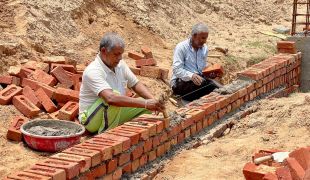Difference between revisions of "Types of manufacturing"
| Line 5: | Line 5: | ||
==Additive manufacturing== | ==Additive manufacturing== | ||
Additive manufacturing (AM) is a process whereby an object is constructed through depositing material in a controlled manner, layer by layer, until a full object is achieved. [[3D printing]] processes are based on the concept of additive manufacturing. | Additive manufacturing (AM) is a process whereby an object is constructed through depositing material in a controlled manner, layer by layer, until a full object is achieved. [[3D printing]] processes are based on the concept of additive manufacturing. | ||
[[File:Bricklaying.jpg|right]] | |||
[[File:Bricklaying.jpg| | |||
==Subtractive manufacturing== | ==Subtractive manufacturing== | ||
Revision as of 13:38, 22 December 2021
Depending on the underlying concept, manufacturing technologies are broadly divided into four groups: additive, subtractive, formative and hybrid.[1]
Additive manufacturing
Additive manufacturing (AM) is a process whereby an object is constructed through depositing material in a controlled manner, layer by layer, until a full object is achieved. 3D printing processes are based on the concept of additive manufacturing.
Subtractive manufacturing
Formative manufacturing
In most formative processes, a liquid is poured into a cavity, taking the cavity's shape as it hardens. Examples include different types of molding, forming and casting.
Formative techniques such as injection molding are often used when a high volume of parts are produced, because fabricating the molds takes a high initial investment, but this mold can then be reused over and over again, reducing the eventual cost per item.
Hybrid manufacturing
- ↑ Sheku Kamara; Kathy S. Faggiani (25 May 2021). Fundamentals of Additive Manufacturing for the Practitioner. John Wiley & Sons. ISBN 978-1-119-75038-3.


